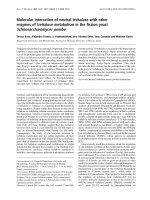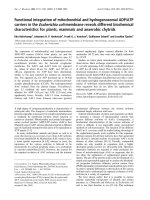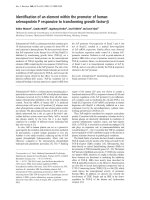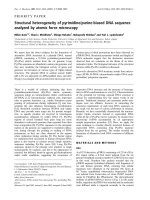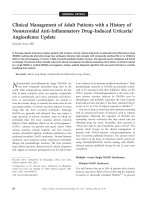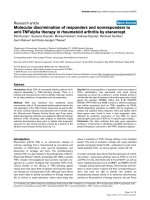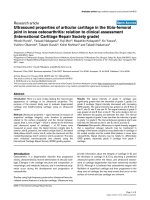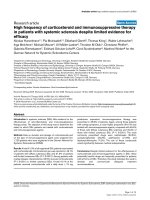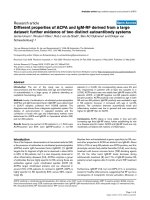Báo cáo y học: " A review of 2004, and with the new year comes a new look" potx
Bạn đang xem bản rút gọn của tài liệu. Xem và tải ngay bản đầy đủ của tài liệu tại đây (30.88 KB, 2 trang )
1
Available online />2004 was a great year for Critical Care. Our impact factor
increased to 1.9, making us the sixth highest ranking
intensive/critical care journal. The ranking that is compiled by
Thompson ISI [1] showed that Critical Care had the second
largest growth in the field. A research article by Rinaldo
Bellomo and colleagues [2] published in May 2004 broke all
of our previous ‘most accessed’ records, charting over
14,000 accesses (this unprecedented visibility was made
possible by the article being Open Access [3,4]).
Furthermore, our research submissions have increased by
57%. We also celebrated our 3000th published article (the
13th in the Statistics Review series, covering receiver
operating characteristic curves [5]); our initial decision time
for manuscripts is now 32 days, which we have reduced from
43 days in 2003; and the number of people registered on the
website broke the 21,000 mark.
The Editorial Board has gained a number of new faces, but
has also seen a number of its members step down. To our
new members, we welcome you to the Editorial Board of
Critical Care. We thank you for your support and look
forward to a long and successful relationship. Our new
Editorial Board members are as follows:
• Bruno Levy
• Can Ince
• Christopher Farmer
• Claudia Spies
• Daniel De Backer
• Djillali Annane
• Emmanuel Rivers
• Herbert Spapen
• John Kellum
• Kenneth Hillman
• Luciano Gattinoni
• Monty Mythen
• Peter Pronovost
To the following members who have stepped down, we thank
you for all of your help and support, wish you great success
for the future, and hope that we can work with you again. The
Editorial Board members who have stepped down are as
follows:
• Antonio Artigas
• Eugen Faist
• Graham Ramsey
• Joachim P Boldt
• Jonathan Cohen
• Peter Suter
• Joseph E Parillo
• Konrad Reinhart
• Lambert G Thijis
• Paul Schumacher
• Pierre Carli
Readers will have seen several additions to the journal over
the past year, including the Statistics Review Series and the
Thematic Series sections [6]. We have also launched a new
type of article – the new Journal Club Critiques from the
University of Pittsburgh [7]. These articles use evidence-
based medicine to critically evaluate a recently published
research article. The article is then open for debate, with the
overall tone of truly trying to understand the implications of
the study. A point is always made to answer the question,
‘Based on the results of this study, should we change clinical
practice?’ In making these available to the online critical care
community, we hope to enrich the consideration of current
literature while providing an evidence-based opinion of
whether each study should change clinical practice (see the
editorial by Milbrandt and Vincent [8]). In 2005 we intend to
continue this trend, providing our readers with the most up-
to-date, educational and exciting articles, covering a wide
range of topics.
Among the biggest changes readers will note this year will be
to the online version of the journal. We have decided to
consolidate the print and online versions by renaming the
online version Critical Care, rather than Critical Care Forum.
The original idea of calling the website a ‘forum’ was to
Editorial
A review of 2004, and with the new year comes a new look
Kerrie Lapworth
1
, Emdadur Rahman
2
and Charlotte Hubbard
2
1
In-house Editor, Critical Care, Editorial office, BioMed Central Ltd, London, UK
2
Assistant editor, Critical Care, Editorial office, BioMed Central Ltd, London, UK
Correspondence: Kerrie Lapworth,
Published online: 14 January 2005 Critical Care 2005, 9:1-2 (DOI 10.1186/cc3051)
This article is online at />© 2005 BioMed Central Ltd
2
Critical Care February 2005 Vol 9 No 1 Lapworth et al.
reflect that the online version contained more than the print
version – a strategy that we helped to pioneer in 1997.
However, this has now become commonplace, making the
need for a different name redundant (instead, we talk about
having different ‘versions’ of the journal). The website URL
will remain the same () because it is
already well known; we are just removing ‘forum’ from the title
of the online version.
We hope the changes we have introduced over the past
year, and will continue to make in the coming years, will
increase your enjoyment of the journal. Some of the ideas we
have in mind for the future include the following:
• making more content online only, to reflect the fact that
most of our users access the journal online rather than
the print version;
• finding faster ways to publish research;
• clinical scenarios; and
• paediatric journal club critiques.
Finally, we, the editorial team at Critical Care, thank all of our
readers, authors, referees and Editorial Board members for
their continued support. There are a number of referees who
have reviewed several articles for us over the past year to
whom we should like to extend special thanks for all of their
hard work, a list of whom can be found at the end of this
issue of the journal and on the website
( />Competing interests
KL, ER and CH are employees of BioMed Central and
receive a fixed salary.
References
1. Thompson ISI: [ />2. Bellomo R, Ronco C, Kellum JA, Mehta RL, Palevsky P, the ADQI
workgroup: Acute renal failure: definition, outcome measures,
animal models, fluid therapy and information technology
needs – the Second International Consensus Conference of
the Acute Dialysis Quality Initiative (ADQI) Group. Critical Care
2004, 8:R204-R212.
3. Tamber PS, Slade E, Vincent JL: Critical Care: a good scientfic
citizen just got better. Crit Care 2003, 7:199-200.
4. Slade E, Tamber PS, Vincent JL: Critical Care's move to fund
open access. Critical Care 2003, 7:331-332.
5. Bewick V, Cheek L, Ball J: Statistics review 13: receiver operat-
ing characteristic curves. Crit Care 2004, 8:508-512.
6. Critical Care’s Thematic Series [ />theme-series.asp]
7. Critical Care’s Journal Club Critiques: [ />browse.asp?sort=Journal%20club%20critique&date=12-2004]
8. Milbrandt EB, Vincent JL: Evidence-based medicine journal
club. Crit Care 2004, 8:401-402.
